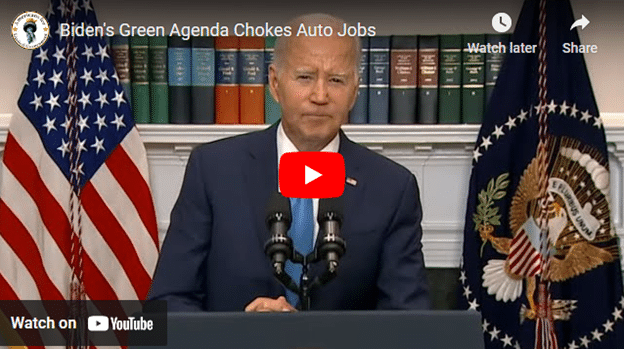September 19, 2023
Permission to republish original opeds and cartoons granted.
5 Easy and Not So Easy Steps to Drain the Swamp

By Rick Manning
For purposes of this article, The Swamp, is defined as the permanent bureaucracy which decides which regulations should be enforced, which ideas from the temporary political appointees should be scuttled or moved forward, who gets hired into the bureaucracy and the disbursement of federal largesse through grants and contracts.
A government which spends $6.2 trillion and exerts power to determine winners and losers between even the largest corporations, will by necessity create a coven of lobbyists, lawyers and procurement specialists to protect and expand their interests. This infrastructure serves as a protective wall which ferociously fights to preserve and expand the fount of their feast, but a significant part of the swamp’s praetorian guard goes way if the amount of power and control exerted by the government is restrained.
The soft underbelly of the swamp is the administrative state itself. The nameless, faceless career federal employees who have no fear of being fired, little stake in the outcome of their actions and every-day push government forward like a slow-moving lava flow consuming everything in its path.
The President and Congress created this sometimes pernicious but largely unthinking monster and they can shrink and restrain it.
Here are the five steps that can and should be taken.
1: FIGURE OUT WHO IS ACTUALLY SHOWING UP TO WORK – Seems basic, but at the end of the Trump administration, the Department of Health and Human Services asked the question, how many employees are even logging in to their computers or mobile devices. Since everyone was ‘working from home’, if you never logged in, you never worked. Obviously people in building maintenance and others did not have the need or ability to log-in, but the result was shocking nonetheless – 25% of those getting paid by taxpayer dollars never once logged in to work from the middle of March to the middle of December in 2020. Every one of them got paid full wages.
Congress needs to compel that the White House Office of Personnel Management provide an annual detailed report on the government-wide log-in habits of its workforce, to allow appropriators to incorporate this information into funding decisions.
Information about the work habits of the administrative state is a first step to draining the swamp, and it is an easy one that could be done now.
2: FOCUS ON THOSE WITH THE REAL POWER IN THE SWAMP – The Senior Executive Service consists of around 7500 people who are the super federal employees. The idea behind the SES is that they are the permanent lever pullers who know how to get things done and can operate equally well in any agency since their role is theoretically operational. This is untrue in many cases.
In reality, many in the SES have their own fiefdoms at agencies that they have been in for years and know better than anyone else. That knowledge gives them immense power as they know who got which grants, which politicians have an interest in the agency and their hot buttons, and in some cases are the hidden sources in government who reporters covering the swamp rely upon. The SES is not bad, but it is the control mechanism for the swamp and it is the vanguard for maintaining the status quo and/or the expansion of government.
Remember, it is extremely rare to find someone who voluntarily surrenders power, and transforming government requires that the power of the administrative state be lessened. The SES are the most skilled and ambitious of the federal employees and they do know how to make government run, or not run. So what can be done?
Get them to retire or move them from their positions of control to new less familiar circumstances.
The first step is simple. As one of the first acts of a new limited government-oriented administration in 2025, Congress should pass legislation which gives all federal employees a short window to retire early with an added two or even three-years of retirement benefits added to their current retirement. Because the SES are largely the most experienced federal employees, they disproportionately nearing or at retirement eligibility.
The stick which is already built into law is that due to the increased money and responsibility of the SES, they can be compelled to accept a transfer within six months. If they do not accept it, they can be fired. Along side the increased retirement incentive, those SES members who have been identified as problems should receive their transfer papers to a new Fargo, ND office that has nothing but bare walls and minimal heat.
Voluntary retirements will come raining in, and the new administration should have already prepared for them by identifying potential replacements who will be honest operators of government rather than political aparatchiks.
3: PASS THE MERIT ACT - The MERIT Act extends to the full government a change in the federal civil service law that was put in place early in the Trump administration in response to the Veteran’s Administration’s Obama era failure to provide health services to veteran’s who were dying out of sheer neglect and incompetence by the federal workforce.
Federal bosses (political appointees, SES members, and upper-level federal employees) cannot fire subordinates, except for in the most egregious cases. Threaten your boss with bodily harm, you cannot be fired. Don’t show up to work, you cannot be fired. Refuse to do your job, you are safe from firing. Incapable of doing your job, once again keep collecting that paycheck.
MERIT Act fixes this by creating an expedited termination process that retains protections for the employees, but also protects the interests of taxpayers that they are not paying people who refuse or cannot do the job.
While this is not a major reform in many people’s eyes, as someone who has managed staff in the federal government, I can testify that often times personnel problems are just ignored or a challenging career person is often just put in a corner with no work rather than wasting valuable time seeking to discipline or remove them. The MERIT Act will, at least, make it worthwhile from a time management perspective to pursue personnel actions against those who can’t or won’t do their jobs in the federal government.
4: REDUCTION IN FORCE – An incoming administration, utilizing the information gained from the first action item, should work with Congress to impose a meaningful Reduction In Force of no less than 15% of the federal workforce which would be a layoff of no fewer than 300,000 people. Fifteen years ago, when I was at the Labor Department, we could have laid off 15 percent of the employees in the division I managed without breathing hard. With increased efficiencies due to the interactivity of technology, this could likely be stretched to 20 percent without losing capacity to serve the public.
Having Congressional buy-in through the first spending bill passed (likely in March of 2025), keeps the RIF from being stopped by federal workforce lawsuits. Legislatively, the RIF should be combined with the retirement buy-outs putting the public employee unions in a slightly more difficult position than they otherwise would find themselves.
5: RECATEGORIZE FEDERAL CAREER ATTORNEYS WHO WORK ON POLICY – President Trump proposed a reform to the federal employment system whereby attorneys who worked on policy were recategorized in a way which eliminated their civil service protections. The reason this matters is that GOP administrations find themselves in policy meetings with career staff who actively resist the policies the administration was elected to implement. This resistance leads to every meeting being leaked in the most unfavorable way imaginable, regulations being undermined by subtle rewrites that create loopholes by those who are paid to get them right, and most importantly, foot dragging which is designed to run out the clock on the politicals until the next election, effectively killing the will of the voters by refusing to do the work.
Known as Schedule F, this idea was being implemented in the waning days of the Trump administration and was immediately tossed out by the Biden administration. It will likely need to be done by Executive Order with the resulting legal fights delaying implementation – potentially for years as the legal system can be very slow particularly when you have to go through the neverTrump DC Circuit gauntlet.
While personnel is policy, it also can be arcane and boring. While these five steps don’t deal with many of the underlying legal issues that have been allowed to fester in the civil service system, passing comprehensive reforms are almost politically impossible. These steps, even the modest RIF, can be accomplished and implemented early in a presidency with a more nimble, responsive federal workforce the result.
The author is the president of Americans for Limited Government.
To view online: https://dailytorch.com/2023/09/5-easy-and-not-so-easy-steps-to-drain-the-swamp/
Video: Biden’s Green Agenda Chokes Auto Jobs

To view online: https://www.youtube.com/watch?v=arq9DxYQn70
Video: Joe Biden’s disastrous economy!

To view online: https://www.youtube.com/watch?v=gDFJgtX4k7Q
House GOP fight over border looms as continuing resolution hangs in the balance and deficit skyrockets past $1.5 trillion

By Robert Romano
On Sept. 30, the fiscal year will end with more than a $1.5 trillion budget deficit as inflation continues to rip through the U.S. and global economy, leaving Congress with much undone as it relates to appropriations. Not a single appropriations bill has passed both chambers and been delivered to President Joe Biden’s desk.
In fact, only a single appropriations bill has passed, the Military Construction and Veterans Affairs bill, on July 17 in the House by a 219 to 211 vote. The rest are just sitting there, albeit reported from committee.
The Senate for its part has yet to pass a single appropriations bill but that will soon change as Military Construction is the first one up on the floor presently. In July, the Senate Appropriations Committee finished all 12 of the appropriations bills, sending them to the floor for Senate Majority Leader Chuck Schumer (D-N.Y.), who is now proceeding with votes.
In the meantime, there is no agreement among the House and Senate for a temporary continuing resolution while Congress finishes the appropriations process, usually culminating with a year-end omnibus bill.
Instead, Congress needs more time, which means it wants a stopgap, creating an opportunity for enterprising Congressmen to attempt to make a deal in exchange for their support.
One such group of 14 House Republicans is led by U.S. Rep. Chip Roy (R-Texas), who seek to attach border security to any spending bill in exchange for advancing any legislation, likely into the fall, giving Congress time to finish the spending bills, but also posing a challenge to House Speaker Kevin McCarthy (R-Calif.).
The U.S. southern border is a catastrophe by every definition of the word, with hundreds of thousands of migrants displaced in post-Covid structural shifts globally pouring into the U.S. every month. President Joe Biden has been dismantling parts of the border wall that former President Donald Trump had built, and cartel activity is peaking.
More than any other issue, securing the border is what many House Republicans in border states ran on in 2022, eking out a narrow majority despite high inflation and a weak economy. That, and the crime that was coming our way in every major city in America now.
Since President Joe Biden took office in Jan. 2017, there have been about 7 million border crossings documented by the U.S. Customs and Border Patrol, according to data from fiscal years 2022 and 2021, but only 1 million were ever expelled, either under Title 42 or Title 8 inadmissibles, by far the most chaotic border in American history.
President Biden might not want to declare a national emergency, but surely we have one that only House Republicans can help to resolve, by giving federal agencies what they need to fight back against a deluge of millions of migrants flooding over the southern border.
The House Republican proposal includes H.R. 2, the Secure the Border Act of 2023, sans a provision on E-Verify that was excluded, a 7.8 percent cut to non-defense spending and several riders that prohibit catch-and-release, bars parole for illegal immigrants, prohibits the use of funds for transportation of illegal immigrants into the U.S. interior and stops Biden's dismantling of the border wall.
Holding back non-defense spending can send a strong message to the Senate that a continuing resolution is not for free, that House Republicans are going to fight for their constituents and protect their communities.
The Secure the Border Act would additionally increase the number of Border Patrol agents, require the resumption of the construction of the southern border wall, criminalize visa overstays, enhance CBP access to international crime reporting data and limiting asylum entries.
Often the question with must-pass spending bills is what to fight over between the branches of government. As the world after Covid continues to see profound chaos economically, displacing supply chains, peoples and entire industries, amid wars, poverty and other calamities, the U.S. is being overrun at the border.
With an unbridled border crisis that is spilling into America’s cities, along with more violent crime, now is the time to take a stand on border security. If the U.S. House cannot help protect the boundaries of the country, how can it expect our cities to do the same?
Robert Romano is the Vice President of Public Policy at Americans for Limited Government.


